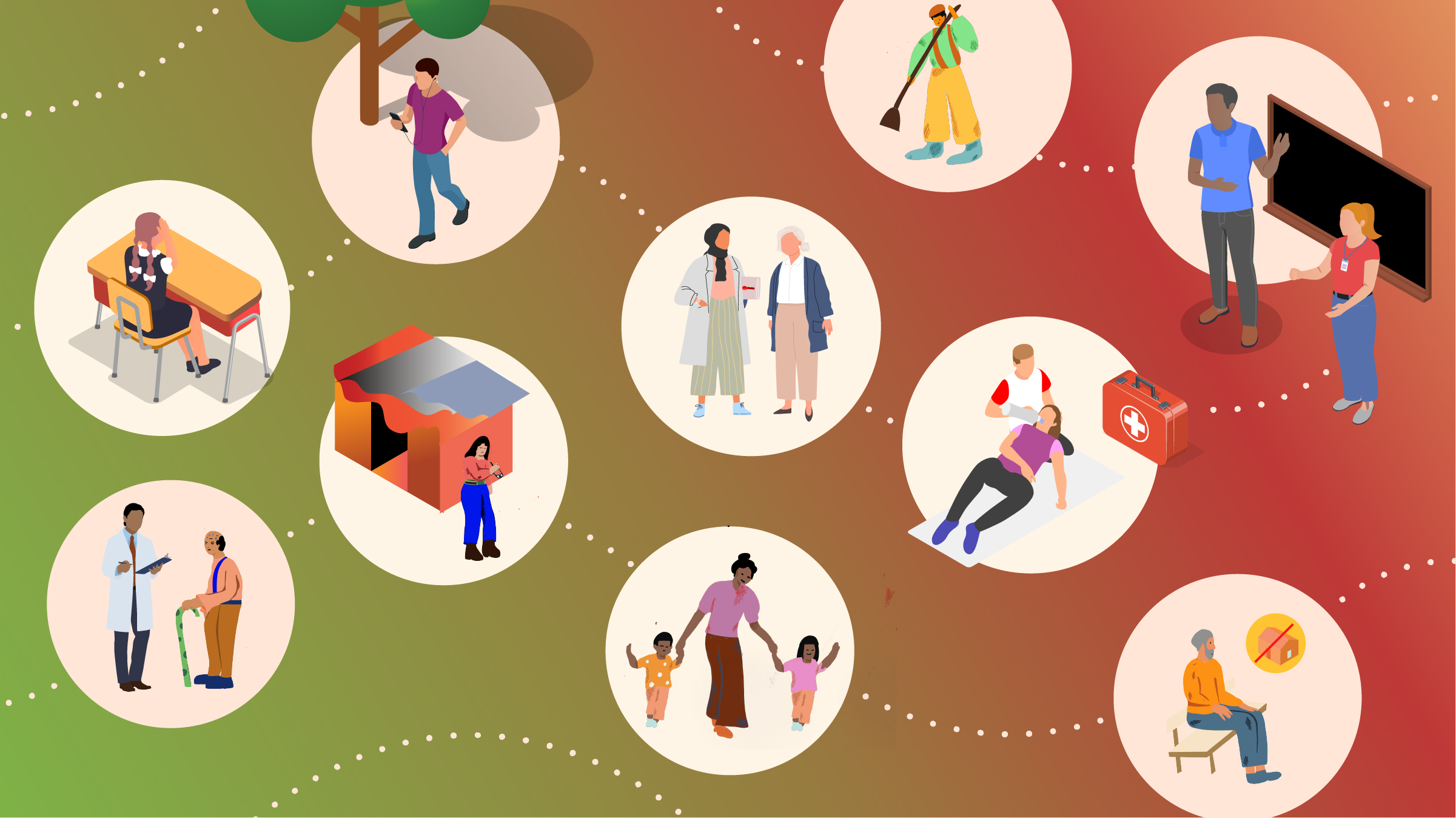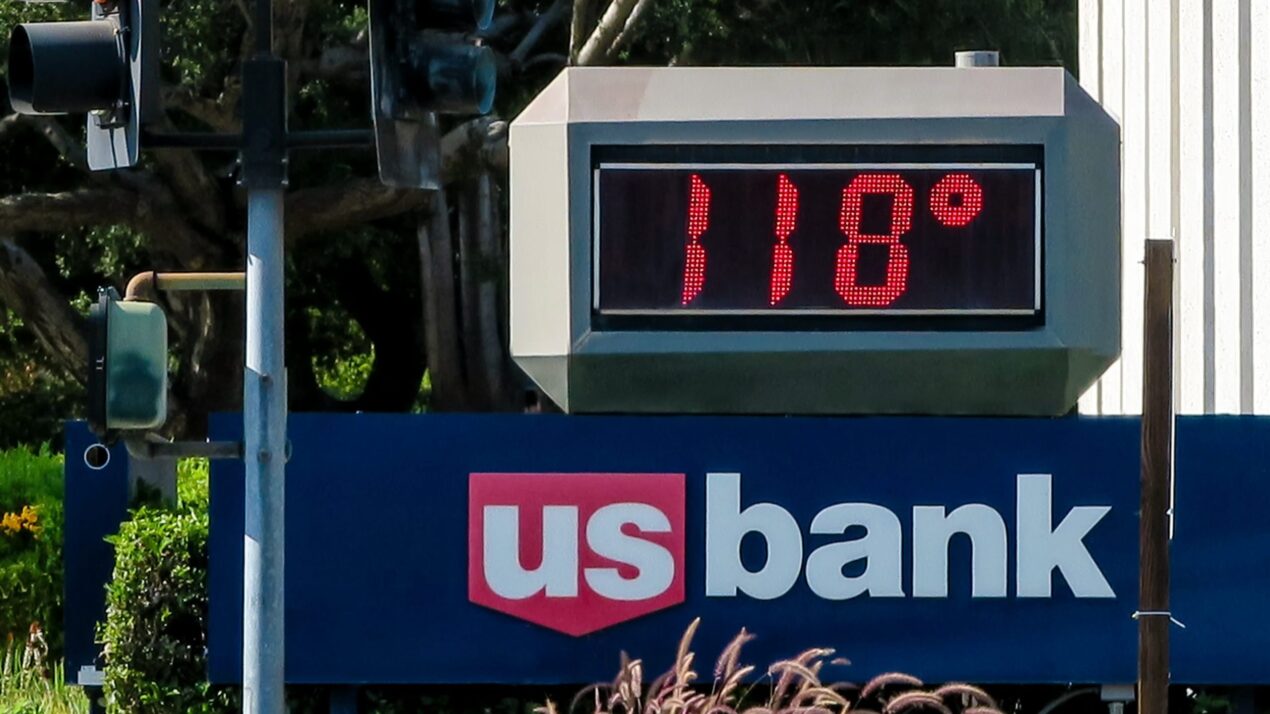Objective
Welcome to the Assess Heat Risk Awareness module! Around the world, people’s perception of the health risks of extreme heat is generally low compared to other climate threats. Given the less visually dramatic qualities of heat compared to hurricanes and floods, the impacts may go unseen. An awareness assessment will build qualitative understanding of the perceptions and impacts of heat. Additionally, it will help identify potential opportunities to build understanding around the risks of heat, grounded in the experiences of community members and stakeholders. Conducting a heat risk awareness assessment can reveal, for example, what your stakeholders currently do to prepare for before and respond during heat waves and inform your planning and preparation moving forward.
Is heat an issue that people recognize as a threat? Do they know how to access and utilize resources to manage extreme heat? People who are aware of the threat of extreme heat will take measures to keep themselves and loved ones safe and be more likely to value resilience policies and programs. The outputs of this module can be used alongside a baseline heat risk assessment and vulnerability assessment to set community-driven goals and values in your projects.
Essential Actions, Outputs, and Outcomes from this Module
Actions
-
Identify the populations that are most impacted by heat and with whom you design (or will design) your heat-related programs and policies.
-
Identify groups (in government, health care, civil society, etc.) who need to understand heat-related risks to best serve heat risk-exposed populations.
-
Create surveys or a series of focus groups of residents and other relevant groups to gauge their perception of heat-related impacts, level of personal urgency around the issue, and other priority data (e.g., knowledge of preparatory actions to take before a heat wave, current adaptation strategies that you and your partners can help support or scale).
Outputs
-
A list of relevant stakeholders (both populations most impacted by heat and those who provide services to those populations).
-
Survey instrument.
-
Survey and focus group data.
Outcomes
-
Understand how to conduct a heat risk awareness assessment.
-
Determine how community members and other key stakeholders view the impact of extreme heat on their community (strengths, weaknesses, opportunities, and threats).
-
Evaluate whether perceptions align with or contradict existing data.
-
Assess whether perceptions of heat’s dangers align with the strategic approach in existing heat risk reduction and adaptation policies and programs.
-
Identify where there is consensus and disagreement among stakeholders on issues that will influence the direction of heat action planning.
Overview
The Essential Actions, Outputs, and Outcomes include the core elements of the more comprehensive approach described throughout the rest of the module. We know that time, resources, and capacity can limit the breadth and depth of interventions you undertake. Simply beginning to explore these modules and consider what solutions are appropriate for your context is a critical step toward building your jurisdiction’s heat resilience. At any point, reach out to Arsht-Rock using the contact form at the bottom of the page with questions and comments.
How to begin a heat risk awareness assessment process
First, establish the time frame and the technical and financial resources available to run the survey. Then decide whether this will be a broad assessment, encompassing all citizens, organizations, and agencies, or if the assessment will be targeted to specific stakeholders (e.g., city government agencies). This will determine the scope and amount of resources necessary to complete the assessment. It is essential to involve community leaders or groups who are subject matter experts on heat’s impacts to advise on the survey design and process in addition to researchers and government officials.
Once you have determined the scope of the assessment, identify key questions that will include. As with most surveys or focus groups, demographic data is important, such as age, income, and educational level. Questions on heat can include:
- Perception of heat exposure, severity, and vulnerability.
- Preparatory and protective measures taken ahead of and during heat waves.
- Awareness of sources of information about heat (early warnings, trusted authorities).
- Economic impacts (related to livelihoods or business continuity) during heat waves.
- Access to cooling or places of respite (air-conditioned community centers, green space, water features)
- Access to and trust in relevant services and support assets.
Though more data is helpful, be mindful that people being surveyed have limited time and attention to complete such assessments.
Resources
Knowledge, Attitudes, Practice & Risk Perceptions Regarding Heatwave Among Outdoor Workers in Nepal
- Nepal
For an example of a survey targeting outdoor workers (including farmers, rickshaw drivers/pullers, street vendors, and others) across 8 districts in Nepal, see pages 28-32 of Joshi et al. (2022)
Extreme Heat Survey
- United States
For an example of a survey focused on community responses to heat in New York City, United States, see the Extreme Heat Survey conducted by WE ACT for Environmental Justice and Columbia University.
Community Knowledge, Attitudes, and Practices Study
- Vietnam
To understand how a humanitarian organization approached a heat risk awareness assessment in a middle-income country, see this overview of a study conducted in Hanoi, Vietnam, by the German Red Cross.
Sweltering Cities 2022 Summer Survey
- Australia
For an example of survey questions and results from a survey conducted by a community-based organization in a high-income country, see a 2022 survey conducted by Sweltering Cities in Australia.
Using assessment outputs
Assessments results should inform your planning and implementation processes, build support for your activities, and facilitate the co-designing of policies and programs. The information may reveal new priorities and concerns within your community or identify primary issues that need to be addressed. If conducted with stakeholders, the process of designing and deploying these assessments can engage community groups, civil society organizations and government agencies on the topic of heat and build political will for further action.
Outputs from a heat risk awareness survey or focus groups can inform or complement a baseline heat risk assessment (see Conduct a Baseline Heat Risk Assessment) or vulnerability mapping (see Identify Heat-Related Vulnerabilities and Impacts).
Resources
Beating the Heat
- Global
For examples of how Sydney, Australia, and Hanoi, Vietnam, used their assessment outputs, please see pages 64-67 of Beating the Heat: A Sustainable Cooling Handbook for Cities, a guidebook developed by the Cool Coalition, the UN Environment Programme, RMI, Global Covenant of Mayors for Climate & Energy, Mission Innovation and Clean Cooling Collaborative.
Beitbridge Residents’ Perceptions of Extreme Heat
- Zimbabwe
For an example of the recommendations and community needs that emerged from a survey conducted in Beitbridge, Zimbabwe, see pages 35-38 and 48-50 of Beitbridge Residents’ Perceptions of Extreme Heat by Chadambuka, Moyo, and Bhatasara (2022).
Common challenges
Common challenges to effectively completing a heat risk awareness assessment include:
- Lack of trust by potential survey participants in data collection process and use of data.
- Low engagement in survey process due to perception of extreme heat as insignificant or standard.
- Lack of time and resources available to commit to the project.
- Difficulty in fully involving stakeholders throughout the process due to limited stakeholder capacity.
- Delays in administrative approval or sign-off from a research ethics review board.
Potential survey participants may have had prior negative experiences with extractive data collection processes or the use of data for purposes that did not benefit them or their communities. One way of increasing survey participation by these participants is to work through partnerships with trusted community organizations and leaders.
In cases where potential survey participants are reluctant to take part because they perceive heat as a non-issue, integrating a component of the survey where you explain the urgency around the issue and how the neighborhood or region has been impacted by heat can help increase participation. However, standardize your approach across survey participants and take into account how the information you provide participants will bias their responses.
To address the cost and time needed to support an assessment, partnering with a local university or civil society organizations such as the Red Cross for subject matter expertise, potential funding or cost-sharing, and volunteers can be helpful. If possible, engaging trusted leaders or known entities within a community in deploying a survey can increase its uptake and reach.
Resource
Heat Risk Perception and Communication Strategies for Adaptation within Low-Income Communities in Kampala City, Uganda
- Uganda
To see how researchers in Kampala City, Uganda addressed residents’ perceptions of the survey as unnecessary, see page 42 of Heat Risk Perception and Communication Strategies for Adaptation within Low-Income Communities in Kampala City, Uganda by Sseviiri et al. (2022)
Congratulations! You’ve completed Assess Heat Risk Awareness.
Review the Essential Actions, Outputs, and Outcomes from this Module or proceed to the next module.






